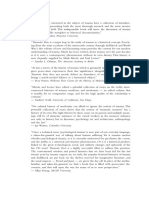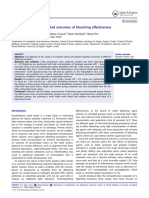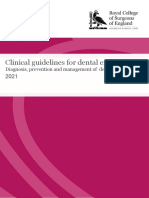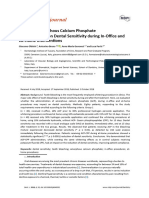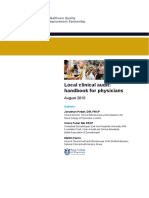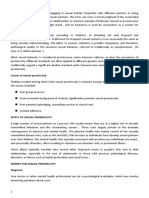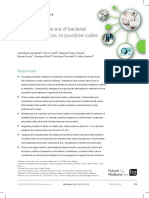P Bleaching
P Bleaching
Uploaded by
pooja singhCopyright:
Available Formats
P Bleaching
P Bleaching
Uploaded by
pooja singhOriginal Title
Copyright
Available Formats
Share this document
Did you find this document useful?
Is this content inappropriate?
Copyright:
Available Formats
P Bleaching
P Bleaching
Uploaded by
pooja singhCopyright:
Available Formats
ORAL HEALTH POLICIES: USE OF DENTAL BLEACHING
Policy on the Use of Dental Bleaching for Child
and Adolescent Patients
Latest Revision How to Cite: American Academy of Pediatric Dentistry. Policy on
2019 the use of dental bleaching for child and adolescent patients.
The Reference Manual of Pediatric Dentistry. Chicago, Ill.: American
Academy of Pediatric Dentistry; 2020:112-5.
Purpose may vary significantly during the mixed dentition. Full arch
The American Academy of Pediatric Dentistry recognizes that cosmetic bleaching during this developmental stage, however,
the desire for dental whitening by pediatric and adolescent would result in mismatched dental appearance once the child
patients has increased. This policy is intended to help pro- is in the permanent dentition. Adolescents present with
fessionals and patients make informed decisions about the unique dental needs, and the impact of tooth discoloration on
indications, efficacy, and safety of internal and external bleach- an adolescent’s self-image could be considered an indication
ing of primary and young permanent teeth and incorporate for bleaching.8 Tooth whitening has been successful in adoles-
such care into a comprehensive treatment plan. cent patients using typical bleaching agents, 8 but research is
lacking on the effects of bleaching on the primary dentition.
Methods Dental whitening may be accomplished by using either
This policy was developed by the Council on Clinical Affairs professional or at-home bleaching modalities. Advantages of
and adopted in 2004. This document is an update from the in-office whitening or whitening products dispensed and
last revision in 2014. This revision included a new literature monitored by a dental professional include:
®
search of the PubMed /MEDLINE database using the terms:
dental bleaching, dental whitening, and tooth bleaching;
• an initial professional examination to help identify causes
of discoloration and clinical concerns with treatment
fields: all; limits: within the last 10 years, humans, English, (e.g., existing restorations, side effects).
clinical trials, and birth through age 18. Over 350 articles • professional control and soft-tissue protection.
were selected and reviewed. Additional information was ob- • patient compliance.
tained from reviewing references within selected articles. • rapid results.
• immediate attention to teeth sensitivity and other adverse
Background effects.
The desire for improved dental esthetics has fueled innovations
in dental materials. Patients, parents, and the news media The pretreatment professional assessment helps identify
request information on dental whitening for children and pulpal pathology that may be associated with a single discol-
adolescents with increasing frequency. In addition, increased ored tooth. This examination also identifies restorations that
demand for bleaching materials and services has affected are faulty or could be affected by the bleaching process and
both the variety and availability of dental bleaching products the associated costs for replacing such restorations to maximize
on the market. esthetic results.8-12 By using photographs and/or a shade guide,
Discoloration of teeth is classified by etiology. 1 Clinical the dentist can document the effectiveness of treatment. In
indications for internal or external dental whitening for addition to providing in-office bleaching procedures, a dentist
individual teeth may include discoloration resulting from a may fabricate custom trays for at-home use of a bleaching
traumatic injury (i.e., calcific metamorphosis, darkening with product. Custom trays ensure intimate fit and fewer adverse
devitalization), irregularities in enamel coloration of a perma- gingival effects.13 Over-the-counter products for at-home use
nent tooth due to trauma or infection of the related primary include bleaching gels, whitening strips, brush-on agents,
tooth, or intrinsic discoloration/staining (e.g., fluorosis, tetra- toothpaste, mints, chewing gum, and mouth rinse. Their main
cycline staining). 2-7 Teeth staining from metals (e.g., iron advantages include patient convenience and lower associated
supplements) or consumption of tea, coffee, soft drinks, costs.
alcohol, and certain foods is extrinsic and easier to treat Peroxide-containing whiteners or bleaching agents improve
compared to intrinsic factors whether congenital or acquired. the appearance by changing the tooth’s intrinsic color. The
Severe discolorations may be best treated with microabrasion professional-use products usually range from 10 percent car-
and subsequent bleaching to achieve desirable results.8 bamide peroxide (equivalent to about three percent hydrogen
Due to the difference in the thickness of enamel of primary peroxide) to 38 percent carbamide peroxide (equivalent to
and permanent teeth, tooth coloration within a dental arch approximately 13 percent hydrogen peroxide). In-office
112 THE REFERENCE MANUAL OF PEDIATRIC DENTISTRY
ORAL HEALTH POLICIES: USE OF DENTAL BLEACHING
bleaching products require isolation with a rubber dam or a Of growing concern is the preponderance of non-dental
protective gel to shield the gingival soft tissues. Home-use professionals offering teeth whitening services to the public.49
bleaching products contain lower concentrations of hydrogen Tooth whitening is defined as any process to whiten, lighten,
peroxide or carbamide peroxide.2-4,14 Efficacy and long-term or bleach teeth.49 Teeth-whitening kiosks and beauty salons
outcomes of home whitening products will vary according to and retail stores are providing whitening services and dis-
the concentration of peroxide used and the severity of the pensing teeth whitening agents.19,50 Dental organizations have
initial tooth discoloration.15-18 Many whitening toothpastes con- supported state regulations that restrict the practice of pro-
tain polishing or chemical agents to improve tooth appearance viding bleaching services to only dentists or other qualified
by removing extrinsic stains through gentle polishing, chem- dental staff under the direct supervision of a dentist.49-51 The
ically chelating, or other nonbleaching action.10,19 Carbamide use of over-the-counter whitening products remains exempt
peroxide is the most commonly used active ingredient in from such regulation. Legislation defining the scope of practice
dentist-dispensed tooth-bleaching products for home-use.10,20 by non-dentists offering whitening treatment varies from state
Side effects from bleaching vital and nonvital teeth have to state and should be examined when these services are
been documented. It should be noted that most of the research being provided.50-52
on bleaching has been performed on adult patients, with only
a small amount of published bleaching research using child or Policy statement
adolescent patients.2,4,8,14,17,21-24 The more common side effects Teeth whitening procedures that have been shown to be safe
associated with bleaching vital teeth are tooth sensitivity and may be beneficial for children and adolescents. Although the
tissue irritation. Tooth sensitivity associated with vital bleach- use of whitening agents can improve dental esthetics and en-
ing may be due to permeation of enamel and dentin by hydro- hance a person’s self-esteem, proper treatment planning with
gen peroxide and a subsequent mild, transient inflammatory objectives should be conducted prior to engaging in any
response.25-27 Hydrogen peroxide is a highly reactive substance bleaching protocol. Use of whitening agents should follow
which can cause damage to oral hard and soft tissues when the safety and efficacy standards as defined by clinical research
used at high concentrations and an extended period of time.28,29 and best practice. Bleaching by young patients should be
Between eight and 66 percent of patients experience post- supervised by an adult and under the guidance of a dentist.
bleaching sensitivity, most often during the early stages of The American Academy of Pediatric Dentistry encourages:
treatment.7,10,14,17,21,24 Overtreatment has been shown to harm • the judicious use of bleaching for vital and nonvital
tooth structure, which is of particular concern when bleaching teeth.
products are used excessively by overzealous teens and young • patients to consult their dentists to determine appro-
adults.29-31 Tissue irritation, in most cases, results from an ill- priate methods for and the timing of dental whitening
fitting tray rather than the bleaching agents and resolves once within the context of an individualized, comprehensive,
a more accurately fitted tray is used.32 Both sensitivity and tissue and sequenced treatment plan.
irritation usually are temporary and cease with the discontinu- • dental professionals and consumers to consider side effects
ance of treatment.6,7,14,17,19,21,24,33,34 Additional risks may include when contemplating dental bleaching for child and
erosion, mineral degradation, pulpal damage, and increased adolescent patients.
marginal leakage of existing restorations.14,35 When used • further research of dental whitening agents in children.
correctly, however, teeth bleaching has been proven to be safe
and causes no irreversible tooth structure damage.29 The American Academy of Pediatric Dentistry discourages
Internal bleaching for non-vital endodontically treated teeth full-arch cosmetic bleaching for patients in the mixed denti-
in young patients can be performed in the same way as for tion and primary dentition.
adults.29 The more common side effect from internal bleaching
of nonvital teeth is external root resorption.36-39 With external References
bleaching of nonvital teeth, the most common side effect is 1. Pinto MM, Leal de Godoy CH, Bortoletto CC, et al.
increased marginal leakage of an existing restoration.3,40-44 One of Tooth whitening with hydrogen peroxide in adolescents:
the degradation byproducts of hydrogen peroxide or carbamide Study protocol for a randomized controlled trial. Trials
peroxide results in a hydroxyl-free radical. This byproduct 2014;15:395.
has been associated with periodontal tissue damage and root 2. Zekonis R, Matis BA, Cochran MA, Al Shetri SE, Eckert
resorption. Due to the concern of the hydroxyl free radical GJ, Carlson TJ. Clinical evaluation of in-office and at-
damage45-47 and the potential side effects of dental bleaching, home bleaching treatments. Oper Dent 2003;28(2):114-21.
minimizing exposure at the lowest effective concentration of 3. Abbott P, Heah SY. Internal bleaching of teeth: An
hydrogen peroxide or carbamide peroxide is recommended. analysis of 255 teeth. Aust Dent J 2009;54(4):326-33.
Providers should use caution when bleaching primary anterior 4. Matis BA, Wang Y, Jiang T, Eckert GJ. Extended at-home
teeth, as the underlying permanent teeth are in jeopardy of bleaching of tetracycline-stained teeth with different
developmental disturbance from intramedullary inflammatory concentrations of carbamide peroxide. Quintessence Int
changes.29,48 2002;33(9):645-55.
THE REFERENCE MANUAL OF PEDIATRIC DENTISTRY 113
ORAL HEALTH POLICIES: USE OF DENTAL BLEACHING
5. Kugel G, Gerlach RW, Aboushala A, Ferreira S, Magnuson 19. American Dental Association Council on Scientific Affairs.
B. Long-term use of 6.5% hydrogen peroxide bleaching Tooth whitening/bleaching: Treatment considerations
strips on tetracycline stain: A clinical study. Compend for dentists and their patients; September 2009, Revised
Cont Educ Dent 2011;32(8):50-6. November 2010. Available at: “https://www.ada.org/~/
6. Bizhang M, Muller M, Phark JH, Barker ML, Gerlach media/ADA/About%20the%20ADA/Files/ada_house_of_
RW. Clinical trial of long-term color stability of hydro- delegates_whitening_report.ashx effectiveness”. Accessed
gen peroxide strips and sodium percarbonate film. Am June 30, 2019.
J Dent 2007;20(Spec No A):23A-27A. 20. Walsh LJ. Safety issues relating to the use of hydrogen
7. Donly KJ, Gerlach RW. Clinical trials on the use of peroxide in dentistry. Aust Dent 2000;45(4):257-60.
whitening strips in children and adolescents. Gen Dent 21. Donly KJ, Donly AS, Baharloo L, et al. Tooth whitening
2002;50(3):242-5. in children. Compend Contin Educ Dent 2002;23(1A):
8. Donly KJ. The adolescent patient: Special whitening 22-28; quiz 49.
challenges. Compend Contin Educ Dent 2003;24(4A): 22. Bacaksiz A, Tulunoglu O, Tulunoglu I. Efficacy and
390-6. stability of two in-office bleaching agents in adolescents:
9. Lima DA, DeAlexandre RS, Martins AC, AGuiar FH, 12 months follow-up. J Clin Pediatr Dent 2016;40(4):
Ambrosano GM, Lovadino JR. Effect of curing lights 269-73.
and bleaching agents on physical properties of a hybrid 23. Giachetti L, Bertini F, Bambi C, Nieri M, Scaminaci
composite resin. J Esthet Restor Dent 2008;20(4): Russo D. A randomized clinical trial comparing at-home
266-73. and in-office tooth whitening techniques: A nine-month
10. Bolay S, Cakir FY, Gurgan S. Effects of toothbrush- follow up. J Am Dent Assoc 2010;141(11):1357-64.
ing with fluoride abrasive and whitening dentifrices on 24. Donly KJ, Segura A, Henson T, Barker ML, Gerlach
both unbleached and bleached human enamel surface RW. Randomized controlled trial of professional at-home
in terms of roughtness and hardness: An in vitro study. tooth whitening in teenagers. Gen Dent 2007;55(7):
J Contemp Dent Pract 2012;13(5):584-9. 69-74.
11. Metz MJ, Cochran MA, Batis BA, Gonzalez C, Platt JA, 25. Bowles WH, Ugwuneri Z. Pulp chamber penetration by
Pund MR. Clincal evaluation of 15% carbamide peroxide hydrogen peroxide following vital bleaching procedures.
on the surface microhardness and shear bond strength J Endo 1987;13(8):375-7.
of human enamel. Oper Dent 2007;32(5):427-36. 26. Cooper JS, Bokmeyer TJ, Bowles WH. Penetration of
12. Mullins JM, Kao EC, Martin CA, Gunel E, Ngan P. the pulp chamber penetration by carbamide peroxide
Tooth whitening effects on bracket bond strength in beaching agents. J Endo 1992;18(7):315-7.
vivo. Angle Orthod 2009;79(4):777-83. 27. Moncada G, Sepulveda D, Elphick K, et al. Effects of light
13. Aushcill TM, Schneider-Del Savio T, Hellwig E, Ar- activation, agent concentration, and tooth thickness on
weiler NB. Randomized clinical trial of the efficacy, dental sensitivity after bleaching. Oper Dent 2013;38(5):
tolerability, and long-term color stability of two bleaching 467-476.
techniques: 18 month follow up. Quintessence Int 2012; 28. Haywood VB, Heymann HO. Nightguard vital bleach-
43(8):683-94. ing. Quintessence Int 1991;22(7):515-23.
14. Dawson PF, Sarif Mo, Smith AB, Brunton PA. A clinical 29. Croll T, Donly K. Tooth bleaching in children and teens.
study comparing the efficacy and sensitivity of home vs J Esthet Restor Dent 2014;26(3):147-150.
combined whitening. Oper Dent 2011;36(5):460-6. 30. Goldberg M, Grootveld M. Lynch E. Undesirable and
15. Demarco FF, Meireles SS, Masotti AS. Over the counter adverse effects of tooth-whitening products: A review.
whitening agents: A concise review. Braz Oral Res 2009; Clin Oral Investig 2010;14(1):1-10.
23(Sec Iss 1):64-70. 31. Lee SS, Zhang W, Lee DH, Li Y. Tooth whitening in
16. Francci C, Marson FC, Briso ALF, Gomes MN. Dental children and adolescents: A literature review. Pediatr
bleaching–Current concepts and techniques. Rev Assoc Dent 2005;27(5):362-8.
Paul Cir Dent 2010;64(1):78-89. 32. Haywood VB. Nightguard vital bleaching: Current con-
17. Donly KJ, Segura A, Sasa I, Perez E, Anastasia MK, Farrell cepts and research. J Am Dent Assoc 1997;127(suppl):
S. A controlled clinical trial to evaluate the safety and 19S-25S.
whitening efficacy of a 9.5% hydrogen peroxide high- 33. Matis BA, Cochran MA, Eckert G, Carlson TJ. The
adhesion whitening strip in a teen population. Am J efficacy and safety of a 10 percent carbamide peroxide
Dent 2010;23(5):292-6. bleaching gel. Quintessence Int 1998;29(9):555-63.
18. Ermis RB, Uzer CE, Yildiz G, Yazkan B. Effect of tooth 34. Da Costa JB, McPharlin R, Paravina RD, Ferracane JL.
discolouration severity on the efficacy and colour stabil- Comparison of at-home and in-office tooth whitening
ity of two different trayless at-home bleaching systems. using a novel shade guide. Oper Dent 2010;35(4):381-8.
J Dent Res Dent Clin Dent Prospects 2018;12(2): 35. Carey CM. Tooth whitening: What we now know. J Evid
120-7. Based Dent Pract 2014;14(Suppl):70-6.
114 THE REFERENCE MANUAL OF PEDIATRIC DENTISTRY
ORAL HEALTH POLICIES: USE OF DENTAL BLEACHING
36. Heithersay GS. Invasive cervical resorption following 46. Anderson DG, Chiego DJ Jr, Clickman GN, McCauley
trauma. Aust Endod J 1999;25(2):79-85. LK. A clinical assessment of the effects of 10 percent
37. Heithersay GS. Invasive cervical resorption: An analysis carbamide peroxide gel on human pulp tissue. J Endod
of potential predisposing factors. Quintessence Int 1999; 1999;25(4):247-50.
30(2):83-95. 47. Kinomoto Y, Carnes DL Jr, Ebisu S. Cytotoxicity of
38. Heithersay GS. Treatment of invasive cervical resorption: intracanal bleaching agents on periodontal ligament cells
An analysis of results using topical application of trichlor- in vitro. J Endod 2001;27(9):574-7.
acetic acid, curettage, and restoration. Quintessence Int 48. Croll T, Pascon EA, Langeland K, Traumatically injured
1999;30(2):96-110. primary incisors: A clinical and histological study. J Dent
39. Attin T, Paqué F, Ajam F, Lennon AM. Review of the Child 1987;54(6):401-22.
current status of tooth whitening with the walking bleach 49. State Board of Dentistry Pennsylvania Dental Association.
technique. Int Endod J 2003;36(5):313-29. Regulating teeth whitening as the practice of dentistry.
40. Teixeira EC, Hara AT, Turssi CP, Serra MC. Effect of Available at: “https://www.padental.org/Online/Advocacy
non-vital tooth bleaching on microleakage of coronal /SBOD_Regulatory_Issues/Regulating_Teeth_Whitening.
access restorations. J Oral Rehabil 2003;30(11):1123-7. aspx”. Accessed March 25, 2019.
41. Ferrari R, Attin T, Wegehaupt FJ, Stawarczyk B, Taubock 50. Otto M. Understanding the legal battles over teeth-
TT. The effects of internal tooth bleaching regimens on whitening. Association of Health Care Journalists.
composite-to-composite bond strength. J Am Dent Assoc Available at: “https://healthjournalism.org/resources
2012;143(12):1324-31. -tips-details.php?id=827#.W-IApNVKiUk”. Accessed
42. Shinohara MS, Rodrigues JA, Pimenta LA. In vitro ®
March 25, 2019. (Archived by WebCite at: “http://www.
microleakage of composite restorations after nonvital webcitation.org/778lRYEFF”)
bleaching. Quintessence Int 2001;32(5):413-7. 51. Litch CS. Supreme court rules against North Carolina’s
43. Sharma DS, Sharma S, Natu SM, Chandra S. An in vitro dental board. Available at: “https://www.aapd.org/assets/
evaluation of radicular penetration of hydrogen peroxide 1/7/LLL.March.2015.pdf ”. Accessed March 25, 2019.
from bleaching agents during intra-coronal tooth bleach- ®
(Archived by WebCite at: “http://www.webcitation.org
ing with an insight of biologic response. J Clin Pediatr /778ly58ce”)
Dent 2011;35(3):289-94. 52. American Dental Education Association State Update.
44. Palo RM, Valera MC, Camargo SE, et al. Peroxide Federal court upholds Georgia Board of Dentistry policy
penetration from the pulp chamber to the external root on teeth whitening. Available at: “https://www.adea.org/
surface after internal bleaching. Am J Dent 2010;23(3): Blog.aspx?id=36111&blogid=20132”. Accessed March
171-4.
45. Firat E, Ercan E, Gurgan S, Yucel OO, Cakir FY, Berker
®
25, 2019. (Archived by WebCite at: “http://www.web
citation.org/778lfyF0T”)
E. The effect of bleaching systems on the gingiva and
the levels of IL-1 Beta and IL-10 in gingival crevicular
fluid. Oper Dent 2011;36(6):572-80. Erratum in Oper
Dent 2012;37(1):108.
THE REFERENCE MANUAL OF PEDIATRIC DENTISTRY 115
You might also like
- Community Development Breaking The Cycle of Poverty PDFDocument2 pagesCommunity Development Breaking The Cycle of Poverty PDFCarlos40% (5)
- Haruchika Noguchi - Ripples and BreathingDocument6 pagesHaruchika Noguchi - Ripples and BreathingТом ВейцманNo ratings yet
- ++L. Mark S. Micale, Paul Lerner-Traumatic Pasts - History, Psychiatry, and Trauma in The Modern Age, 1870-1930-Cambridge University Press (2001)Document333 pages++L. Mark S. Micale, Paul Lerner-Traumatic Pasts - History, Psychiatry, and Trauma in The Modern Age, 1870-1930-Cambridge University Press (2001)juaromer50% (2)
- IAPD20 Virtual Abstract Book CompressedDocument991 pagesIAPD20 Virtual Abstract Book CompressedAnonymous NqTjEcNo ratings yet
- Policy On The Use of Dental Bleaching For Child and Adolescent PatientsDocument4 pagesPolicy On The Use of Dental Bleaching For Child and Adolescent PatientsFebriani SerojaNo ratings yet
- Vital Tooth Bleaching An Update by StrasslerDocument12 pagesVital Tooth Bleaching An Update by StrassleranjozzNo ratings yet
- MetodologiaDocument6 pagesMetodologialiliana.aguilarNo ratings yet
- Aapd EnameloplastyDocument9 pagesAapd EnameloplastydrkameshNo ratings yet
- Aapd Guidelines - Restorative DentistryDocument8 pagesAapd Guidelines - Restorative DentistrymahmoudNo ratings yet
- G RestorativeDocument8 pagesG RestorativeEllizabeth LilantiNo ratings yet
- DT Oct 13 NPR Milnar Fnl1Document9 pagesDT Oct 13 NPR Milnar Fnl1Kranti PrajapatiNo ratings yet
- A Clinical Evaluation of A Bleaching Agent Used With and Without Reservoirs Matis Et Al, 2002 IIDocument7 pagesA Clinical Evaluation of A Bleaching Agent Used With and Without Reservoirs Matis Et Al, 2002 IIEugenioNo ratings yet
- CCIDEN 15943 A Concise Review Regarding Erosion and Abrasion On Tooth STR 071511Document8 pagesCCIDEN 15943 A Concise Review Regarding Erosion and Abrasion On Tooth STR 071511Floria DimitriuNo ratings yet
- Content ServerDocument7 pagesContent ServerGreisy Saym Cruz FelixNo ratings yet
- Tooth-Bleaching: A Review of The Efficacy and Adverse Effects of Various Tooth Whitening ProductsDocument6 pagesTooth-Bleaching: A Review of The Efficacy and Adverse Effects of Various Tooth Whitening ProductsMuhammad AbazaNo ratings yet
- Adolescent Dental Health CareDocument8 pagesAdolescent Dental Health CarerachmaniabudiatiNo ratings yet
- Aapd Guidelines - Restorative Dentistry PDFDocument8 pagesAapd Guidelines - Restorative Dentistry PDFMaqbul AlamNo ratings yet
- Stain Removing and Whitening by Baking Soda Dentifrice PDFDocument7 pagesStain Removing and Whitening by Baking Soda Dentifrice PDFDoruNo ratings yet
- 1 Blanqueamiento de Dientes, Lo Que Sabemos AhoraDocument7 pages1 Blanqueamiento de Dientes, Lo Que Sabemos AhoraDaniel VelezNo ratings yet
- Bansal 2012Document6 pagesBansal 2012carmen mendo hernandezNo ratings yet
- Longevity of RestorationsDocument12 pagesLongevity of RestorationsmusaabsiddiquiNo ratings yet
- Managing Discoloured Teeth' With YouDocument29 pagesManaging Discoloured Teeth' With YoudentistryrashaNo ratings yet
- Guideline On Pediatric Restorative Dentistry: Originating Committee Review Council Adopted RevisedDocument7 pagesGuideline On Pediatric Restorative Dentistry: Originating Committee Review Council Adopted RevisedEduardo SánchezNo ratings yet
- Literature Review Teeth WhiteningDocument4 pagesLiterature Review Teeth Whiteninggw1357jx100% (1)
- Clinician Capstone 11Document29 pagesClinician Capstone 11api-472652222No ratings yet
- Cosmetic DentistryDocument143 pagesCosmetic DentistryPeter Osundwa KitekiNo ratings yet
- Tooth WhiteningDocument3 pagesTooth WhiteningrizwanNo ratings yet
- Denu.2024.51.3.171.pdf Filename UTF-8''denu.2024.51.3.171Document5 pagesDenu.2024.51.3.171.pdf Filename UTF-8''denu.2024.51.3.171Rafaqat AliNo ratings yet
- Modern Thoughts On Fissure SealantsDocument5 pagesModern Thoughts On Fissure SealantsSaca AnastasiaNo ratings yet
- G SealantsDocument17 pagesG SealantsAngie Peterson VillamizarNo ratings yet
- Clinical and Patient Reported Outcomes of Bleaching EffectivenessDocument9 pagesClinical and Patient Reported Outcomes of Bleaching EffectivenesscosadedubsNo ratings yet
- Blanqueamiento DentalDocument8 pagesBlanqueamiento DentalThe Music ShineNo ratings yet
- Tooth Bleaching - Home Bleaching TechniqueDocument4 pagesTooth Bleaching - Home Bleaching TechniqueGalgalo GarbichaNo ratings yet
- Effectiveness of A Desensitizing Agent Before In-Office Tooth Bleaching in Restored TeethDocument7 pagesEffectiveness of A Desensitizing Agent Before In-Office Tooth Bleaching in Restored TeethFer TorresNo ratings yet
- Guidelines BookDocument16 pagesGuidelines BookAdel ElaroudNo ratings yet
- Erosion Guidelines - 2021 - V4 - MJDocument32 pagesErosion Guidelines - 2021 - V4 - MJAARON DIAZ RONQUILLONo ratings yet
- Dental Trauma GuidelinesDocument16 pagesDental Trauma GuidelinesKhushbu AggarwalNo ratings yet
- OpalescenceTreswhite OrthoDocument3 pagesOpalescenceTreswhite OrthomartacciNo ratings yet
- Children Dental ProceduresDocument188 pagesChildren Dental ProceduresIrina Panciu StefanNo ratings yet
- 2022 Article 721Document8 pages2022 Article 721cosadedubsNo ratings yet
- Bleaching Induced Tooth Sensitivity Do TDocument6 pagesBleaching Induced Tooth Sensitivity Do TCatalinBojeNo ratings yet
- A Clinical Evaluation of Two in Office Bleaching Products Shethri Et Al, 2003Document8 pagesA Clinical Evaluation of Two in Office Bleaching Products Shethri Et Al, 2003EugenioNo ratings yet
- Review of Related Literature and Studies: Pediatr Dent 10 (4), 328B329, 2009members of The College ofDocument4 pagesReview of Related Literature and Studies: Pediatr Dent 10 (4), 328B329, 2009members of The College ofZoella ZoeNo ratings yet
- Tooth Whitening: Current Status and ProspectsDocument11 pagesTooth Whitening: Current Status and ProspectsDANTE DELEGUERY100% (1)
- AAPD Policy On Minimally Invasive DentistryDocument4 pagesAAPD Policy On Minimally Invasive DentistryDani BrenerNo ratings yet
- BleachingDocument275 pagesBleachingorthomed100% (5)
- P ProphylaxisDocument5 pagesP ProphylaxisLeticia Quiñonez VivasNo ratings yet
- Dental Hygiene Dissertation TopicsDocument7 pagesDental Hygiene Dissertation TopicsIWillPayYouToWriteMyPaperUK100% (1)
- Ultradent Catalogue ANZ 2013Document134 pagesUltradent Catalogue ANZ 2013Dorin PupezNo ratings yet
- Dentsplay AdhesivesDocument16 pagesDentsplay AdhesivesAdina Ioana BordianuNo ratings yet
- At-Home Vital Bleaching A Comparison of Hydrogen PeroxideDocument6 pagesAt-Home Vital Bleaching A Comparison of Hydrogen PeroxideanjozzNo ratings yet
- Current Oral Health Status in The PhilippinesDocument9 pagesCurrent Oral Health Status in The PhilippinesRose MirallesNo ratings yet
- Dissertation Topics in Conservative DentistryDocument8 pagesDissertation Topics in Conservative DentistryProfessionalPaperWritingServicesUK100% (1)
- Nagehan Yılmaz, Ozgul Baygin, Tugba Nigar Cakıroglu, Tamer Tüzüner, Orhan DegerDocument6 pagesNagehan Yılmaz, Ozgul Baygin, Tugba Nigar Cakıroglu, Tamer Tüzüner, Orhan DegerJOSE VALDEMAR OJEDA ROJASNo ratings yet
- Improving Aesthetics in Patients With Complete DenturesDocument4 pagesImproving Aesthetics in Patients With Complete DenturesMohsin HabibNo ratings yet
- Oral Health: Samuel Zwetchkenbaum, DDS, MPH, and L. Susan Taichman, RDH, MPH, PHDDocument20 pagesOral Health: Samuel Zwetchkenbaum, DDS, MPH, and L. Susan Taichman, RDH, MPH, PHDwesamkhouriNo ratings yet
- Dentistry Journal Class ADocument16 pagesDentistry Journal Class ANelly Fitriani SiregarNo ratings yet
- Incidence of Tooth Sensitivity After Home Whitening TreatmentDocument14 pagesIncidence of Tooth Sensitivity After Home Whitening TreatmentjofiaNo ratings yet
- Esthetic Oral Rehabilitation with Veneers: A Guide to Treatment Preparation and Clinical ConceptsFrom EverandEsthetic Oral Rehabilitation with Veneers: A Guide to Treatment Preparation and Clinical ConceptsRichard D. TrushkowskyNo ratings yet
- Demin/Remin in Preventive Dentistry: Demineralization By Foods, Acids, And Bacteria, And How To Counter Using RemineralizationFrom EverandDemin/Remin in Preventive Dentistry: Demineralization By Foods, Acids, And Bacteria, And How To Counter Using RemineralizationNo ratings yet
- MultimediaDocument15 pagesMultimediapooja singhNo ratings yet
- JIndianSocPedodPrevDent372214-17904 045824Document4 pagesJIndianSocPedodPrevDent372214-17904 045824pooja singhNo ratings yet
- Dental Management Towards Sickle PatientsDocument6 pagesDental Management Towards Sickle Patientspooja singhNo ratings yet
- JIDA SickleCellDocument6 pagesJIDA SickleCellpooja singhNo ratings yet
- Pex 06 01Document5 pagesPex 06 01Elvis Nor FitrianaNo ratings yet
- Infographic 1 - Tendinopathy Management With Daniel SilvanDocument1 pageInfographic 1 - Tendinopathy Management With Daniel SilvanKeefe TanNo ratings yet
- Drug CardsDocument2 pagesDrug CardsMichael LongsNo ratings yet
- Family Nursing Care Plan CHN CasasDocument8 pagesFamily Nursing Care Plan CHN CasasKj KimNo ratings yet
- Aerobic Training: Fact or Fiction?Document10 pagesAerobic Training: Fact or Fiction?Kim Taehyung0% (1)
- Clinical Audit For PhysiciansDocument46 pagesClinical Audit For PhysiciansTatiana Araujo100% (2)
- (1479683X - European Journal of Endocrinology) Incidence of GH Deficiency - A Nationwide StudyDocument11 pages(1479683X - European Journal of Endocrinology) Incidence of GH Deficiency - A Nationwide StudysavitageraNo ratings yet
- The Placebo EffectDocument14 pagesThe Placebo EffectMichelle WenasNo ratings yet
- DAC First Quarter 2021Document52 pagesDAC First Quarter 2021Armi CaberoNo ratings yet
- St. Paul University PhilippinesDocument7 pagesSt. Paul University PhilippinesAshley DayagNo ratings yet
- FluticasoneDocument4 pagesFluticasonevanNo ratings yet
- Causes of Sexual PromiscuityDocument3 pagesCauses of Sexual PromiscuitySamson ArimatheaNo ratings yet
- Code Blue TraningDocument9 pagesCode Blue TraningPRADIPNo ratings yet
- UNICEF Kenya Country Kit 2020-2022Document22 pagesUNICEF Kenya Country Kit 2020-2022Brian OmariNo ratings yet
- Xi WajibDocument6 pagesXi WajibAries ChristiawanNo ratings yet
- Fibroid With PregnancyDocument5 pagesFibroid With PregnancyvaishaliNo ratings yet
- Archetypes - Aboreal, Dragon, PlagueDocument5 pagesArchetypes - Aboreal, Dragon, PlagueTal Shimshon DekelNo ratings yet
- TPN Total Parenteral Nutrition Recovered..Document17 pagesTPN Total Parenteral Nutrition Recovered..sakhawatNo ratings yet
- SchizophreniaDocument35 pagesSchizophreniaEduardo GonzalezNo ratings yet
- CriolipolizaDocument11 pagesCriolipolizaroxanaNo ratings yet
- Stahl' Essential Psychopharmacology 285Document1 pageStahl' Essential Psychopharmacology 285Muhammad AzkaNo ratings yet
- Sustainable Agriculture Reviews 46: Harsh Panwar Chetan Sharma Eric Lichtfouse EditorsDocument245 pagesSustainable Agriculture Reviews 46: Harsh Panwar Chetan Sharma Eric Lichtfouse EditorsOscar Salvador Falcon PeñaNo ratings yet
- Antiseptics in The Era of Bacterial Resistance A Focus On Povidone IodineDocument14 pagesAntiseptics in The Era of Bacterial Resistance A Focus On Povidone IodinewatidinaNo ratings yet
- Introduction To ParasitologyDocument21 pagesIntroduction To Parasitologyning ningNo ratings yet
- Ethnobotanical Study of Acalypha Wilkesiana (Euphorbiaceae), A Plant Used in The Treatment of Arterial Hypertension in Oyem in Northern GabonDocument6 pagesEthnobotanical Study of Acalypha Wilkesiana (Euphorbiaceae), A Plant Used in The Treatment of Arterial Hypertension in Oyem in Northern GabonOpenaccess Research paperNo ratings yet
- Upper Intermediate: Level 2Document4 pagesUpper Intermediate: Level 2AngolTeadélutánAdrivalNo ratings yet
- Ignatavicius Chapter 59 (Evolve), Ignatavicius Chapter 57 (Evolve), GI CH 56, 57, 58, 59 Ignatavicius, Ignatavicius Chapter 54 (Evolve), Sole Ch 19, Ignatavicius Chapter 63 (Evolve), Sole Ch 16 Flashcards _ QuizletDocument63 pagesIgnatavicius Chapter 59 (Evolve), Ignatavicius Chapter 57 (Evolve), GI CH 56, 57, 58, 59 Ignatavicius, Ignatavicius Chapter 54 (Evolve), Sole Ch 19, Ignatavicius Chapter 63 (Evolve), Sole Ch 16 Flashcards _ QuizletNursyNurseNo ratings yet


